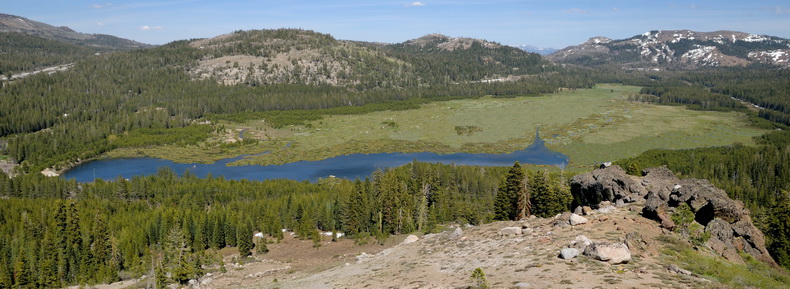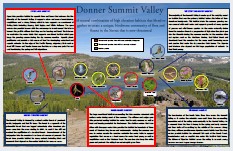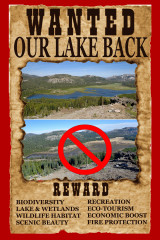 After the latest move by the Land Trust to drain Van Norden Lake there are a lot of questions from residents at Donner Summit and Summit lovers everywhere. There is a story running in the Sierra Sun right now that does attempt to clarify what is going on, but unfortunately the reporter apparently only spoke with the Land Trust and the article contains much of their misinformation. Here is a reality check on many of the arguments made by the Land Trust in that article.
After the latest move by the Land Trust to drain Van Norden Lake there are a lot of questions from residents at Donner Summit and Summit lovers everywhere. There is a story running in the Sierra Sun right now that does attempt to clarify what is going on, but unfortunately the reporter apparently only spoke with the Land Trust and the article contains much of their misinformation. Here is a reality check on many of the arguments made by the Land Trust in that article.
California Law made us do it
It is true that the present release of water from Van Norden Lake is due to orders by the Water Resource Control Board (WRCB). This is due in large part to the fact that despite their knowledge at the time of the property purchase, the Land Trust failed to respond to requests by the WRCB to apply for the water rights (see their letter to the Royal Gorge receiver from 2012 by clicking here). This was in 2012 when the Land Trust did plan to maintain a 49 acre-ft lake in the valley. Due to their inaction over the last 3 years the WRCB had no choice but to order the Land Trust to release the water. It is very interesting how the Land Trust portrays themselves as “working with the WRCB, when the reality is the WRCB’s order was a direct reaction to the lack of response by the Land Trust (see this letter from June of this year by clicking here). It doesn’t really sound like they are “working together”. Moreover it is clear that it is the lack of action by the Land Trust to apply for water rights that is the reason for the order.
Many people have asked how the Land Trust can do this now without going through the CEQA process. This is not a permanent change to the dam as their plan to notch the spillway 5 ft is. This situation applies just to fact that the Land Trust is now the operator of the dam and the WRCB is only ordering that the water be released because they have failed to apply for the water rights. So now the Land Trust is releasing the water just as the winter rains and snow are coming. Water flows of 500-1000 cfs are common during the winter and spring months. The 24 inch drainage pipe at the dam will not be able to drain the lake at winter flow rates and with the heavy winter snows that the summit receives it will not be practical to set up the pumps that were used in the current release. The result is that the lake will fill again during the winter and the spring melt that follows. And yet the Land Trust claims they will be dispersing “native” plant seeds on the newly exposed lakebed. It makes no sense to start seeding the lake bottom at this time when the seeds will certainly be washed away by spring melt waters.
There are no other viable options available
The article discusses a number of options such as rebuilding the dam or removing it. Both of these options are very expensive and are probably not viable. However it should be made clear that the plan that the Land Trust is going to propose is the breaching of the dam’s current spillway by 5 feet to lower the level. It is so interesting to hear people talk about the “removal” of the dam when the Land Trust has no intention of removing any part of the dam other than the 5 ft of spillway. The reason, it would be expensive and the Land Trust does not want to spend any more money then they have to (see below).
Since the reporter only got the Land Trust spin and did not talk with people opposing this move like us he of course completely missed the most viable option. That option is of course the compromise to notch the dam only 2.3 ft and leave a 49 acre-ft lake in the valley This is the original option that the Land Trust proposed and not only would it preserve some of the lake and wetland habitat but the notching would not cost any more money. It would meet the safety requirements of the California State Department of Safety of Dams (DSOD). It would still require securing water rights and our group (SaveVanNordenLake.Org) has offered to finance that option to allay the costs to the Land Trust.
The Land Trust wants to “transfer” the land to the Forest Service
The use of the word “transfer” is a clever little ploy that the Land Trust likes to use when referring to their deal with the Forest Service. It doesn’t sound as crass as the fact that in truth they are “selling” the land to the Forest Service for $2 million dollars. This adds a significant financial motivation to any actions made by the Land Trust. It also makes it clear that despite it’s proclamations about the future of the Summit Valley, the Land Trust does not really have any future stake in what happens in the valley. That financial considerations don’t play a role here is belied by the fact it wasn’t until the beginning of 2014 when the Forest Service announced it would not pay for the land if the lake was present that the Land Trust adopted the plan for draining the lake. Contrary to the statement in the article, the transfer of the land and the plan to “restore” the meadow by draining the lake are completely interdependent. The simple fact is that if they don’t drain the lake, they don’t get the money.
 Draining the lake will improve the habitats in the Summit Valley
Draining the lake will improve the habitats in the Summit Valley
The current meadow lake and wetlands provide a rich blend of habitats that serve to increase the biodiversity of the Summit Valley. The aquatic habitats of the lake make the valley a breeding ground for waterfowl, fish and amphibians. The unique shallow water habitat of the lake make it a hot bed for Western Toad breeding. Hundreds of thousands of toads populate the valley in the summer due to the lake and wetlands. Migratory birds such as Sand Hill Cranes and Tundra Swans use the lake as a stop on the Pacific Flyway. It is hard to understand how the removal of over 100 acres of lake and surrounding marshland habitat and all the flora and fauna that depend on it will result in an increase in the biodiversity. And yet you hear this again and again from the Land Trust. To paraphrase the immortal words of Inigo Montoya, we don’t think the word (biodiversity) means what the Land Trust thinks it means. Wetland wildlife habitat already flourishes in the valley. It is also difficult to understand how removing 70 acres of open lake and replacing it with meadow that already predominates the valley will increase the fishery. In fact, it is the lake that now supports the existing fishery. Contrary to what was said in the article, historically it is very doubtful that there were any fish at the summit prior to the 1800s due to the high elevation, cold temperatures and heavy snow. It was only after the dam was built the lake was stocked in the 1800s that any fishery existed on the Summit Valley.
And probably most perplexing is the statement that habitat for the endangered Willow Flycatcher will be increased. Currently there are 70 acres of willow marshlands surrounding the lake and serving as perfect breeding habitat which requires not only willows but also open water. It’s pretty clear to anyone that takes a walk through the valley to see that the willows propagate around the lake where they get enough water. Removing the lake and dropping the water table 5 ft in the valley will decrease the willow population significantly because the willow roots only go 24 inches deep. You just need to look at how sparse the willows are at the east end of the valley where there is no lake to know what will happen to the willows once the lake is removed.
The reality is that increasing existing drier meadow habitat at the expense of sensitive lake and wetland habitat just makes no environmental sense. However, draining the lake and selling the land for $2 million makes perfect financial sense.



